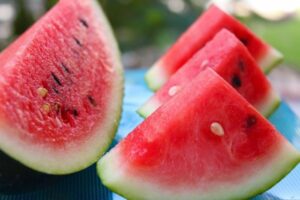How long is a watermelon good for – Watermelons, a symbol of summer and hydration, offer a refreshing and nutritious treat. However, like all perishable fruits, their shelf life is a crucial factor in ensuring optimal quality and safety. This comprehensive guide delves into the intricacies of watermelon storage, consumption, and spoilage, providing practical tips and essential information to help you enjoy this summer staple at its best.
From understanding the factors that influence a watermelon’s longevity to identifying signs of spoilage and implementing effective storage techniques, this guide equips you with the knowledge to maximize the enjoyment of this juicy fruit while minimizing waste.
Shelf Life of Watermelons: How Long Is A Watermelon Good For
Watermelons are a delicious and refreshing fruit that can be enjoyed all summer long. But how long do watermelons last? The shelf life of a watermelon depends on several factors, including storage conditions, variety, and ripeness.
Uncut watermelons can be stored at room temperature for about a week. Once cut, watermelons should be stored in the refrigerator for up to 3-4 days. Watermelons can also be stored in cold storage for up to 2 months.
Factors Affecting Shelf Life
The following factors can affect the shelf life of watermelons:
- Storage conditions: Watermelons should be stored in a cool, dark place. Avoid storing watermelons in direct sunlight or in areas with high humidity.
- Variety: Some varieties of watermelons have a longer shelf life than others. For example, seedless watermelons typically have a longer shelf life than seeded watermelons.
- Ripeness: Ripe watermelons will have a shorter shelf life than unripe watermelons.
Signs of Spoilage

A fresh watermelon is a juicy and refreshing treat, but it’s important to know how to identify signs of spoilage to avoid consuming spoiled fruit. Here are some visual, textural, and olfactory cues that indicate a watermelon has gone bad:
Visual Cues
- Mold: Mold growth on the rind or flesh of the watermelon is a clear sign of spoilage. It can appear as white, black, green, or blue patches and should be discarded immediately.
- Bruises: Bruises on the rind can indicate internal damage. While small bruises may not affect the edibility of the fruit, large or soft bruises may indicate that the watermelon has been damaged during transportation or storage.
- Cracks: Cracks in the rind can allow bacteria and mold to enter the fruit, leading to spoilage. Avoid watermelons with cracks or open wounds.
Textural Cues, How long is a watermelon good for
The texture of a watermelon can also indicate spoilage:
- Soft or mushy flesh: The flesh of a ripe watermelon should be firm and crisp. If it is soft or mushy, it has likely overripened or spoiled.
- Slimy rind: A slimy or sticky rind is a sign that the watermelon has been exposed to moisture and bacteria. It should be discarded immediately.
Olfactory Cues
The smell of a watermelon can also indicate spoilage:
- Sour or fermented odor: A sour or fermented smell indicates that the watermelon has begun to spoil. It should be discarded immediately.
- Musty or moldy odor: A musty or moldy odor is a sign that the watermelon has been contaminated with mold. It should be discarded immediately.
If you notice any of these signs of spoilage, it is best to discard the watermelon immediately. Consuming spoiled watermelon can lead to foodborne illness, so it is important to be vigilant in identifying and discarding spoiled fruit.
Storage Techniques
/how-to-grow-watermelons-1403491-hero-2d1ce0752fed4ed599db3ba3b231f8b7.jpg?w=700)
To extend the shelf life of watermelons, proper storage is crucial. Ideal conditions involve cool temperatures and adequate humidity.
Store whole watermelons in a cool, dark place with good air circulation. Avoid direct sunlight and exposure to extreme heat or cold. Temperatures between 50-55°F (10-13°C) are optimal.
Refrigerating Cut Watermelons
Cut watermelons can be refrigerated for up to 3-5 days. Wrap the cut surfaces tightly with plastic wrap or store them in an airtight container to prevent dehydration and contamination.
Freezing Cut Watermelons
For longer storage, cut watermelons can be frozen for up to 10-12 months. Cut the watermelon into chunks or slices, place them on a baking sheet lined with parchment paper, and freeze for several hours until solid. Transfer the frozen pieces to airtight freezer bags or containers.
Consumption Guidelines
Once cut, watermelons have a limited shelf life due to the increased exposure to bacteria and other microorganisms. It’s crucial to follow proper consumption guidelines to ensure food safety and minimize the risk of foodborne illnesses.
Cut watermelon should be refrigerated at all times and consumed within 3-4 days. This time frame is shorter than whole watermelons due to the increased surface area for bacteria to grow. Proper storage and handling are essential to maintain the quality and safety of cut watermelon.
Spoilage Risks
- Bacterial growth: Cut watermelon provides an ideal environment for bacteria to multiply, leading to spoilage and potential food poisoning.
- Mold development: Mold can quickly spread on cut watermelon, making it unsafe for consumption.
- Yeast fermentation: Yeast can cause cut watermelon to ferment, resulting in an unpleasant taste and odor.
Additional Considerations
/when-to-harvest-watermelon-2539591-04-f7f99d3a73d846cb9d453f8a6f0cc7ee.jpg?w=700)
Delving deeper into the world of watermelons, we explore additional factors that influence their shelf life, nutritional value, and cultural significance.
Organic Farming Practices
Organic farming methods prioritize natural processes, eschewing synthetic fertilizers and pesticides. Watermelons grown organically tend to have a shorter shelf life compared to conventionally farmed counterparts due to the absence of preservatives.
Health Benefits and Freshness
Watermelons are nutritional powerhouses, boasting antioxidants, vitamins, and minerals. Consuming fresh watermelons ensures optimal nutrient intake. As the fruit ages, its nutritional content gradually diminishes.
Cultural Practices
Watermelons hold cultural significance across various regions. In some cultures, they are carved into intricate shapes for decorative purposes or used in traditional festivals. Local storage and consumption practices vary, influenced by cultural traditions and climate.
Conclusion
By adhering to proper storage and handling practices, you can extend the shelf life of your watermelons, ensuring they remain a refreshing and wholesome treat throughout the season. Remember, a watermelon’s journey from field to table is a delicate balance of nature and human care. By understanding the intricacies of their storage and consumption, we can savor the sweet taste of summer while minimizing waste and maximizing enjoyment.
FAQ Corner
Can I store uncut watermelons at room temperature?
Yes, uncut watermelons can be stored at room temperature for up to a week. Choose a cool, dry place away from direct sunlight.
How can I tell if a watermelon has gone bad?
Look for signs of mold, bruises, or soft spots. The flesh should be firm and the rind should not have any cracks or punctures.
How long can I store cut watermelon in the refrigerator?
Cut watermelon can be stored in the refrigerator for up to 3-4 days. Place it in an airtight container to prevent dehydration.







Leave a Comment